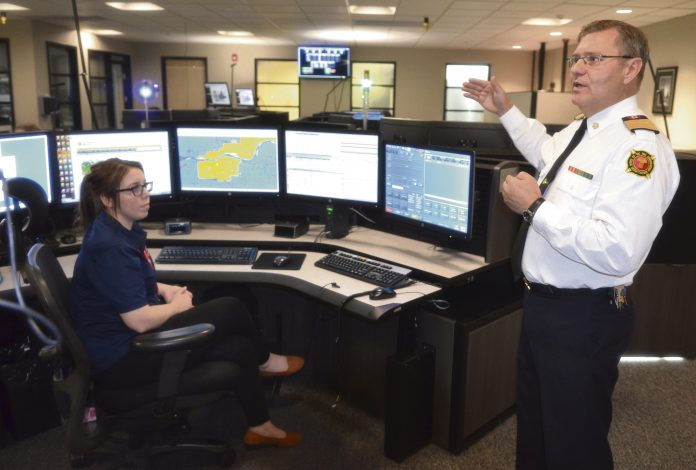
A Saskatchewan-based not-for-profit is taking over management of the provincial 911 centre located just north of town.
CanOps has been selected to manage the Provincial Emergency Communications Centre, part of the Sask911 system. The selection was announced in a press release Wednesday.
CanOps will take over from the City of Prince Albert, which was previously managing the operations of the centre from a small room in the basement of City Hall. The transition to provincial control was announced last year, coinciding with the opening of the new communications centre, which is located inside the federal government’s satellite centre about 10 minutes outside of Prince Albert on Highway 55. CanOps will report to the Saskatchewan Public Safety Agency, a Treasury Board Crown created in 2017, which is responsible for Sask911.
“We are honoured to be selected to take on the management of this important and essential service for the province of Saskatchewan,” President of CanOps John Saunders said in a news release.
“We will continue to work with the province on a seamless transition and to ensure that the transition does not affect the delivery of services or the staff. Going forward, we will ensure that we maintain the excellence in levels of service and support that the community has come to expect.”
According to Duane McKay, assistant deputy minister and commissioner of emergency management and fire safety with the Ministry of Government Relations, staff will not be impacted by the change in management.
“We had a couple of conditions. One was that they needed to maintain all of the staff and keep them as whole as possible,” he said.
“We recognize the staff are the true value here as they handle calls on a day-to-day basis. We’re very happy that CanOps agreed to all of those things.”
The transfer of service was initiated by the City of Prince Albert, McKay said. When the 911 service was set up a number of years ago, Saskatoon and Regina became responsible for calls within city limits, and Prince Albert a small area outside of those centres. Over the years, Prince Albert’s responsibility grew to include all 911 calls from outside of Saskatoon and Regina, along with dispatching for about 360 fire services, as well as support for conservation officers and other government agencies.
The expanded requirements began to outgrow both the space provided for it and the ability of the city to manage the service. Prince Albert and the province began to work together to transition the city away from operating the service.
The creation of a new Crown corporation to manage 911 services was announced last year.
“Rather than bringing (the 911 centre) into government, we felt more comfortable working with a partner,” McKay said, “so we went through a selection process.”
Over the past few months, work has been ongoing to transition staff from the city over to CanOps. The company will answer to the Crown corporation, similar to how Prince Albert, Saskatoon and Regina have been reporting back on their 911 operations.
“They all answer to us in terms of program standards and how the system is going to be used,” McKay said.
‘We support them with technology and pay for some staffing to answer calls in all three of those centres.”
McKay said the new communications centre, which opened last year, has served the province well and provides room to expand. The operations centre now has four times as much space, which is vital as call volumes continue to increase.
Nicole Rancourt, the NDP’s Government Relations Critic, has been watching the transition closely.
“I talked with the minister in-depth about this in … (the) spring because this is a new development for our 911 services and its something that is a trial kind of situation.”
In an exchange between Rancourt and McKay during a spring estimates debate, as recorded in the Hansard, McKay provided similar answers to the MLA as he did to the Herald.
“(CanOps) is really just a partner,” McKay told Rancourt.
“Much the same as if the city was to say, we’ll look after the employees, we’ll look after … the day-to-day management, but all of the standards, all of the coordination, the program itself, will be firmly in the hands of the government to ensure that we get what we need and the employees and the stakeholder,s the client, get what they need.”
McKay said CanOps assists governments in managing things they don’t want to or can’t. The term, he said, is for ten years.
“They can own; they can manage; they can run,” he said.
“They are looking after the employees. They will ensure that all of those things that a good employer needs to do are there. But the program itself will stay with the Government of Saskatchewan.”
Rancourt’s concern, other than maintaining the level of service for users of the 911 system, is for jobs of people who work at the centre and live in Prince Albert.
“The headquarters … and a lot of jobs are right here in Prince Albert. My priority is to make sure we keep the headquarters, we keep the jobs, don’t lose any positions and ensure that employees continue to be compensated fairly,” she said.
So far, she hasn’t seen any indications of any major changes.
“That’s good,” Rancourt said, “but I’ve been making it very clear that I will be keeping my eye on that, and have been in touch with the union representing those workers.”
McKay thanked the city of Prince Albert for its partnership and said he’s looking forward to working with CanOps to manage the communication centre’s day-to-day operations.
‘We’ve had a very good relationship with the City of Prince Albert over the last 17 years, and we’re thankful for all they did to help build this system,” he said.
“We look at these things as partnerships. With our new partner CanOps, we’re really excited about the potential for long-term system stability.”

